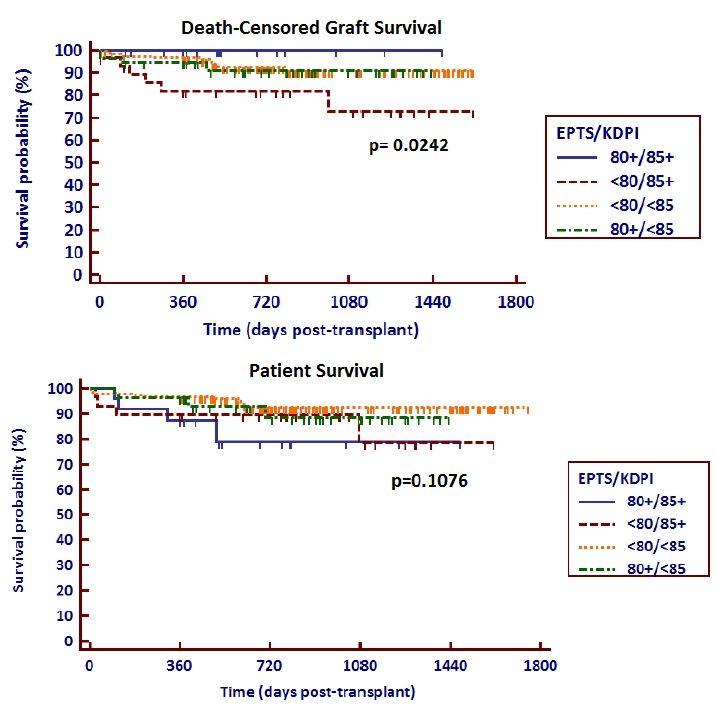Analysis of Outcomes in High Risk Kidney Transplants.
Kidney and Pancreas Transplantation, NewYork-Presbyterian Weill Cornell Medical Center, New York, NY
Meeting: 2017 American Transplant Congress
Abstract number: 506
Keywords: Allocation, Graft survival, Kidney transplantation, Outcome
Session Information
Session Name: Concurrent Session: Economics and Outcomes in Organ Transplantation
Session Type: Concurrent Session
Date: Tuesday, May 2, 2017
Session Time: 4:30pm-6:00pm
 Presentation Time: 5:18pm-5:30pm
Presentation Time: 5:18pm-5:30pm
Location: E271a
Background: The new kidney allocation system implemented in 12/2014 utilizes estimated post-transplant survival scores (EPTS) and kidney donor profile index (KDPI) to optimize recipient survival and kidney graft longevity. The Organ Procurement and Transplantation Network defines high risk transplants as kidney recipients with EPTS > 80 receiving a kidney KDPI > 85. There is an ongoing aversion to performing high risk transplants among centers due to fear of flagging by regulatory bodies. As a program that performs high risk transplants, we sought to assess our clinical outcomes in this patient population.
Methods: This is a single center, retrospective analysis of adult kidney patients who received a deceased donor kidney transplant between 1/1/2012-12/31/2015. Patients were categorized into quadrants of EPTS 80+/KDPI 85+ (group 1), EPTS < 80/KDPI 85+ (group 2), EPTS < 80/KDPI <85 (group 3), and EPTS 80+/KDPI< 85 (group 4). Kaplan-Meier (KM) analyses were used to assess patient and death-censored graft survival.
Results: Among a cohort of 294 kidney transplant patients, KM overall 1-year patient survival was 95.2% and death-censored graft survival was 95.1%. Eight percent of cases were considered high risk transplants (group 1) followed by 9.9% in group 2, 63% in group 3, and 18.7% in group 4. KM patient survival at 1 year was 87.5%, 89.7%, 96.8%, and 96.4%, respectively. Death-censored graft survival at 1 year was 100%, 81.8%, 96.7%, and 94.5%, respectively. Delayed graft function was highest in group 1 patients (54.1%). Incidence of biopsy proven acute rejection was highest in group 1 and 2 with 12.5% and 10.3%.
 Conclusion: Our results demonstrate successful outcomes with high risk kidney transplants. However, the outcomes observed in the EPTS <80/KDPI 85+ group warrants furthers investigation and analysis of this patient population.
Conclusion: Our results demonstrate successful outcomes with high risk kidney transplants. However, the outcomes observed in the EPTS <80/KDPI 85+ group warrants furthers investigation and analysis of this patient population.
CITATION INFORMATION: Liu E, Aull M, Lee J, Kapur S. Analysis of Outcomes in High Risk Kidney Transplants. Am J Transplant. 2017;17 (suppl 3).
To cite this abstract in AMA style:
Liu E, Aull M, Lee J, Kapur S. Analysis of Outcomes in High Risk Kidney Transplants. [abstract]. Am J Transplant. 2017; 17 (suppl 3). https://atcmeetingabstracts.com/abstract/analysis-of-outcomes-in-high-risk-kidney-transplants/. Accessed December 21, 2025.« Back to 2017 American Transplant Congress
